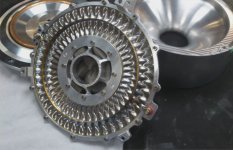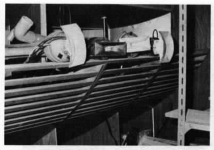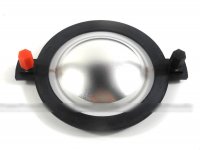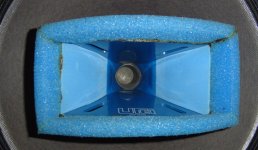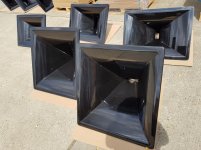The diaphragm isn't a regular dome, but a circumferentially, AxiPeriodic, annular diaphragm and therefore the voicecoil is located in the middle.
The underside looks like this:
The underside looks like this:
Attachments
Last edited:
The mouth round-overs are interesting. FWIW, the original Iwata horns - the ones he used at home - had a unique termination. The edges were slotted. Ro808 will know what I mean.
At the mouth edge Mr Iwata broke up the surface into slats with progressively wider gaps as the curve moved out. It was meant to allow a progressive transition from hard surface to soft termination. Or perhaps from high impedance to low impedance. The idea came from his work on reducing shock wave at the mouths of the high speed train tunnels.
That is a very interesting idea, thanks. Do you remember if the slots were axial or radial?
Ro, I'm interested in the diaphragm pleating. Wouldn't there be extra stress at the folds that will eventually cause them to tear? I suspect it doesn't need to be this elaborate to reduce the simple breakup modes but maybe it should be, to provide axisymmetry and reduce stress?
The diaphragm isn't a regular dome, but a circumferentially, AxiPeriodic, annular diaphragm and therefore the voicecoil is located in the middle.
The underside looks like this:
Thanks for showing me why I'll never open it......until they come out with a aluminum or beryllium replacement diaphragm..... =/
That is a very interesting idea, thanks. Do you remember if the slots were axial or radial?
There are horizontally mounted slats (with increased spacing) and the actual 'vents' (vertical), each with different proportions.
Iwata used 36!!! drivers for each channel of his bass horn.
This man was a true genius. He developed more than 180 different horn types and over 400 different horns (weighing up to 800kg each)
He was remarkably gifted in mathematics/physics and rejected most of the existing theories and works of Olson, Klipsch et al.
Attachments
Last edited:
Thanks. I wonder if that concept could be adapted for MF horns. Maybe not slots, but some other geometry like holes.
Thanks. I wonder if that concept could be adapted for MF horns. Maybe not slots, but some other geometry like holes.
Hmm...try to envision going from one extreme to the other, a fully developed horn in one end of the scale and Karlson-tube in the other. This is something i have thought of on many occasions but where always too lazy to build and test.
//Anders
Ro, I'm interested in the diaphragm pleating. Wouldn't there be extra stress at the folds that will eventually cause them to tear? I suspect it doesn't need to be this elaborate to reduce the simple breakup modes but maybe it should be, to provide axisymmetry and reduce stress?
A Quote:
"For his PhD thesis, Jack Oclee-Brown published research showing just how the inherent modes of vibration in a compression driver diaphragm are prone to coupling with the acoustic modes in the driver cavity, producing all manner of unwanted resonances in the output—research that was also only possible using computer-based analysis of the underlying physics at work in compression drivers. The research concluded that an annular, or ring-shaped diaphragm, could suppress these resonances if carefully designed. Mark Dodd, our head of Group Research, came up with the idea of a periodically symmetrical, corrugated ring diaphragm, which would combine strength with modal suppression.
All these avenues of research combine in the Axi2050, which employs a single voice coil and the thin, annular, gently curved 175 mm-diameter titanium diaphragm designed by Dodd and Oclee-Brown, together with a multiple-aperture phase plug. After five years of research, the precise nature of the three-dimensional corrugation and its rotational symmetry about the newly named ‘axiperiodic’ diaphragm was finalized using modeling techniques to reduce the modal resonances in the driver to an absolute minimum, and the gentle curvature ensured that the first breakup mode is very high for a five-inch diaphragm.
Furthermore, because the titanium diaphragm is thin and very low in mass, it is sensitive enough to accurately reproduce frequencies up to 20 kHz, but at the same time sufficiently resilient and large in diameter to reproduce frequencies down to 300 Hz, at high SPLs if required. The large diameter also conferred another benefit: The compliance of the driver changes little with large excursions at low frequencies, which keeps low-frequency distortion (to which human hearing is particularly sensitive) at a minimum. Finally, the wideband response meant one driver could cover the entire MF/HF range, doing away with the need for a mid-to-high-frequency crossover—another of our design team’s aims."
In this video Dr. Brown elaborates on the specifics of the Axi2050.
Thanks for showing me why I'll never open it......until they come out with a aluminum or beryllium replacement diaphragm..... =/
Don't worry about that, they won't 😉
Speaking of diaphragm materials, throughout this thread, many great drivers have been discussed, both classic and contemporary.
Nearly all the classics share a common feature, an Aluminum diaphragm.
Today, Radian is the only company that mass produces Aluminum diaphragms for their own as well as third party drivers (TAD, JBL).
Since the 1930's Vitavox has only produced Aluminum diaphragms for their drivers. Initially these were hard suspended, but they switched to a soft surround later. An example was shown here.
18Sound offers the ND2060A:
"The ND2060A 2 inch exit neodymium HF compression driver has been designed for high quality sound systems application.
The ND2060A diaphragm assembly is composed by an aluminum dome sandwiched to a proprietary treated PEN (polyethylene naftalate) suspension. This design maintains low resonance and lowers the minimum crossover point value at 800 Hz. The composite diaphragm assembly is made by an aluminum dome strongly joined to the PEN suspension, in order to assure unmatched transient response. The lower density of the aluminum and PEN structure permits higher levels of sensitivity, especially in the mid-high frequency range."
ND2060 Titanium diaphragm:
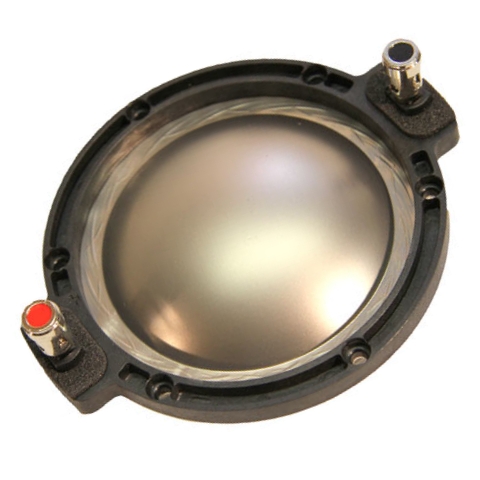
ND2060A(luminum) diaphragm:
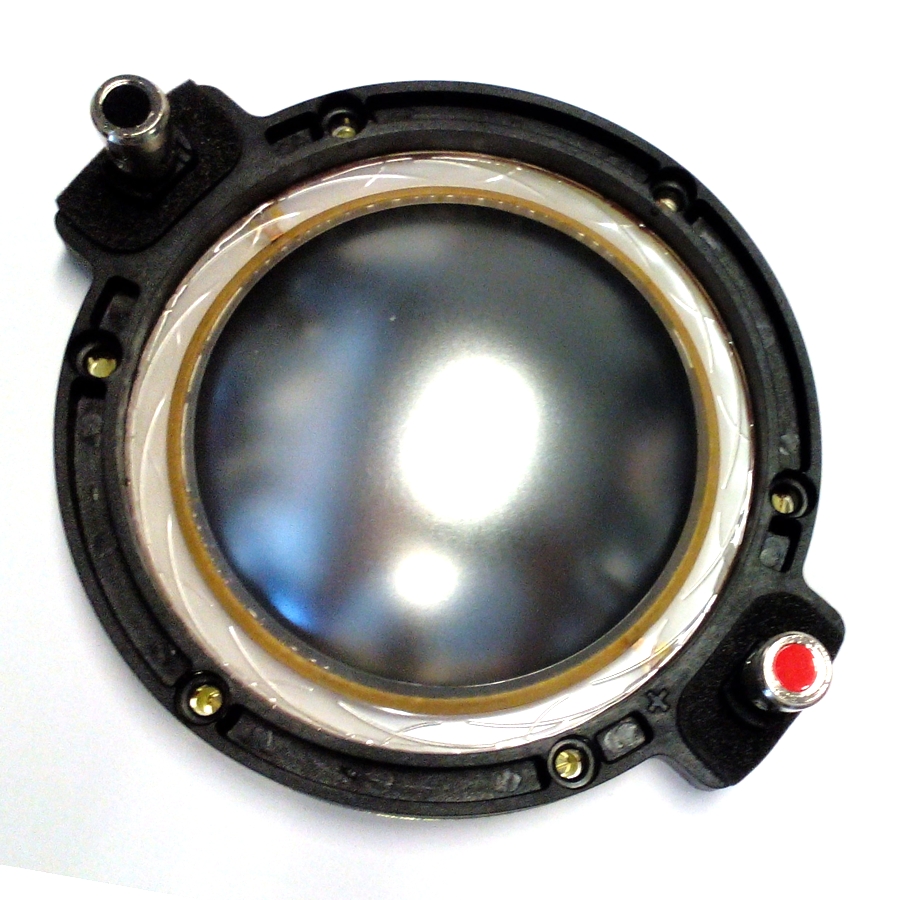
A couple of posts ago, I referred to the older B&C 3" drivers such as the B&C DE75-8, DE75TN, DE750-8, DE750TN, DE82,DE82TN, DE85, DE85TN, as well as the EAW, Nexo, Yorkville etc. branded counterparts.
2 interchangeable diaphragms are available for these drivers, the MMD3AM (Mylar surround):

or the MMD3ATN (Titanium surround):

Because of the steep prices of these (contrary to some modern diaphragms of i.e Faital Pro), there's an abundance of cheap aftermarket diaphragms available. These clones are getting better each year. I've read some reports of people who actually preferred clones to the originals.
As a domestic user, it's highly unlikely you'll ever blow a diaphragm, but what if you saw one these?
2 interchangeable diaphragms are available for these drivers, the MMD3AM (Mylar surround):

or the MMD3ATN (Titanium surround):

Because of the steep prices of these (contrary to some modern diaphragms of i.e Faital Pro), there's an abundance of cheap aftermarket diaphragms available. These clones are getting better each year. I've read some reports of people who actually preferred clones to the originals.
As a domestic user, it's highly unlikely you'll ever blow a diaphragm, but what if you saw one these?
Attachments
I have used soft termination at the horn mouth that had easily measurable improvements - audible too, but not "night and day." Always keeping Mr Iwata's slotted horns in mind I've tried going from a dense to a loose soft edge.Thanks. I wonder if that concept could be adapted for MF horns. Maybe not slots, but some other geometry like holes.
But I didn't pursue that enough to know if it really helped.
Urie Horn Slots Foam edge and denser foam panels inside.
Rob🙂
Rob🙂
Attachments
Last edited:
Urie Horn Slots Foam edge and denser foam panels inside.
Rob🙂
According to the Urei-813B Specsheet:
"The Series 8 monitors have the patented high frequency horn, with its diffraction buffer for correct acoustic impedance matching and smooth out-of-bandresponse, and the shadow slots which eliminate the midrange shadowing common to conventional coaxial loudspeaker horns."
At Audioasylum someone stated the slots in the Urei horns function as a kind of physical notch-filter. A notch-filter aka high Q band-stop filter, which makes sense.
What if you'd mount a much bigger horn in front of the coaxial woofer, so that it would completely isolate the cone, except for the slots...?
I am not a filter expert by any means, but wouldn't the slots turn into bandpass-filters?
Or...

What if you'd mount a much bigger horn in front of the coaxial woofer, so that it would completely isolate the cone, except for the slots...?
I am not a filter expert by any means, but wouldn't the slots turn into bandpass-filters?
Or...

Last edited:
The slits/slots of the Urei 813 horn are also referred to as Helmholtz resonators, which makes the "notch filter theory" plausible.
Earlier in this thread, the 8" Sica Coaxial (8 C 2 CP) was mentioned. The horn of this unit is perforated to improve coupling with the woofer.
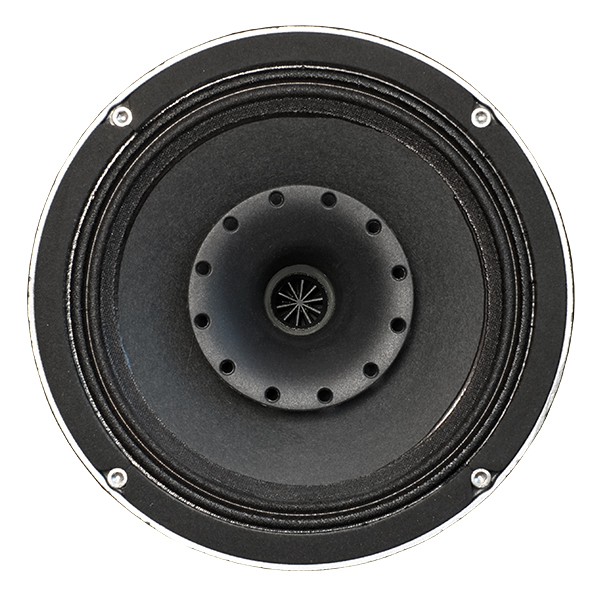
Earlier in this thread, the 8" Sica Coaxial (8 C 2 CP) was mentioned. The horn of this unit is perforated to improve coupling with the woofer.
The Axi horns taken outside.
The pinched, but otherwise fairly smooth slots are clearly visible.
The pinched, but otherwise fairly smooth slots are clearly visible.
Attachments
Last edited:
The Axi horns taken outside.
The pinched, but otherwise fairly smooth slots are clearly visible.
You’d think they make a version that can play down to 300hz
If they did I would already have a pair!!You’d think they make a version that can play down to 300hz
Here is another try to hit camplos requirements. It is complete different approach with an algorith inspired by JMLC and using diffenrent progressive expansion T functions for horizontal and vertical:

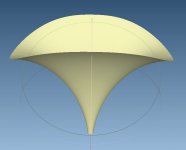
View attachment drba_jmlc_hvdiff.zip


View attachment drba_jmlc_hvdiff.zip
- Home
- Loudspeakers
- Multi-Way
- Is it possible to cover the whole spectrum, high SPL, low distortion with a 2-way?
